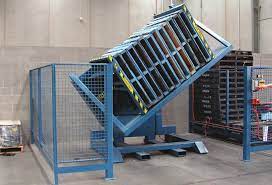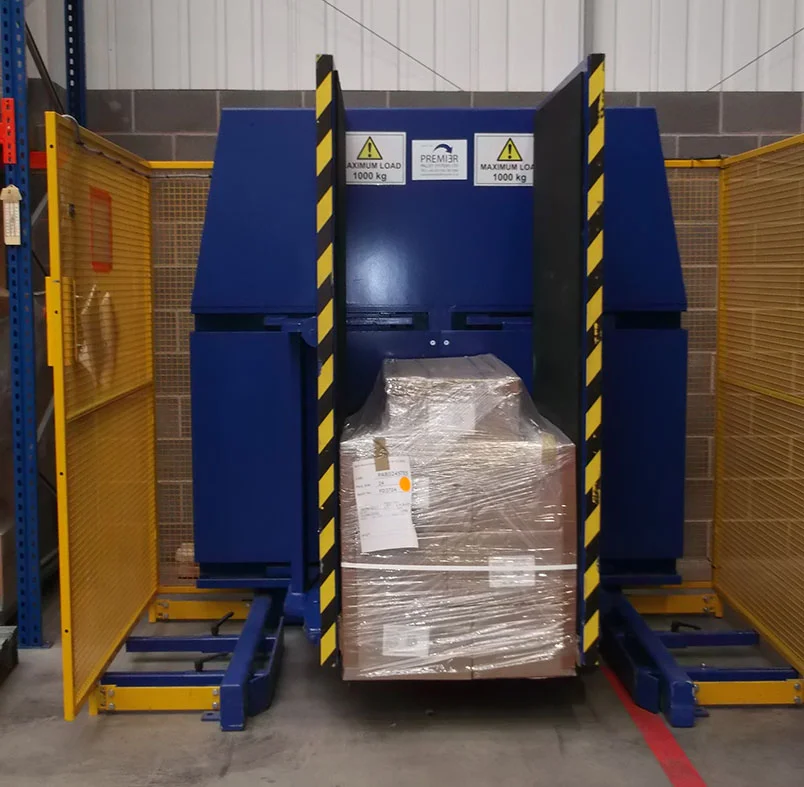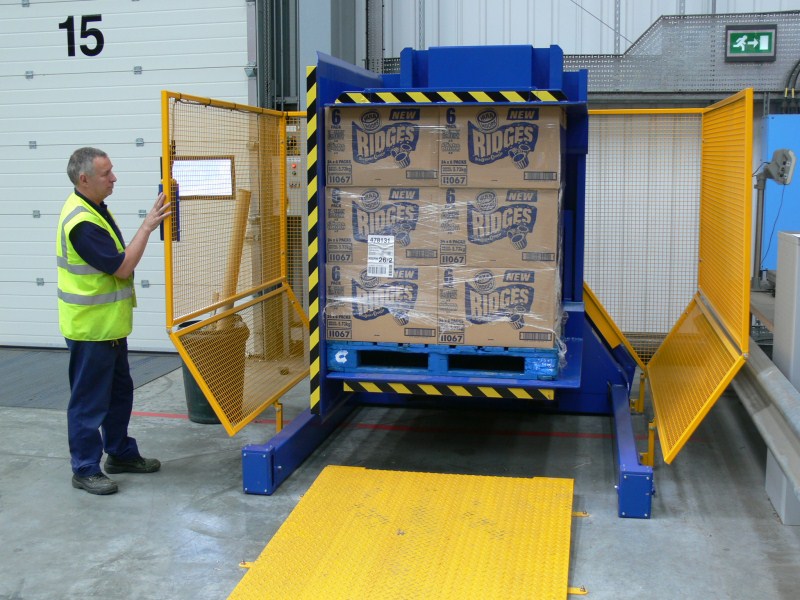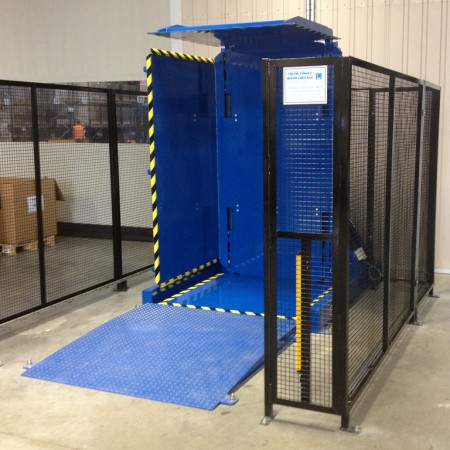Pallet Inverter: How Do Steel Mills Handle Heavy Coil Pallet Changes Safely?
Handling multi-ton steel coils is a daily reality in any steel mill. But the process of changing the pallet beneath one of these giants is filled with risk. A slight imbalance, a moment of inattention, or a failure of standard equipment can lead to catastrophic accidents, damaged products, and costly downtime. I have seen firsthand how traditional methods using forklifts and manual labor turn a simple task into a high-stakes gamble, putting both people and profits in danger. This is a problem that keeps plant managers and owners like you awake at night. But what if there was a way to make this process not just safer, but faster and more efficient?
The safest and most efficient way for modern steel mills to handle heavy coil pallet changes is by using a specialized machine called a pallet inverter. This equipment securely clamps the coil and its pallet, rotates the entire load 180 degrees, and allows for the old pallet to be removed and replaced at ground level. This process eliminates dangerous manual handling and unstable forklift maneuvers, making the operation fast, controlled, and secure.

This machine is more than just a piece of equipment; it's a strategic solution to a fundamental operational challenge. It directly addresses the core issues of safety, efficiency, and cost that every steel mill owner faces. In this article, we will explore exactly how a pallet inverter transforms this critical process. We'll look at the tangible benefits for your workers and your bottom line. And I will share my personal insights as an engineer on what to look for when investing in this technology.
How can a pallet inverter improve operational safety and reduce worker injuries?
Your people are your most valuable asset. Yet, every day, they work near massive, heavy loads. The process of changing a pallet under a steel coil using a forklift and crowbars is one of the most hazardous jobs on the factory floor. One slip can lead to a crushing injury or worse. As an owner, you are not just responsible for their safety; you bear the financial and emotional weight of any accident. The solution is to engineer the risk out of the process, and a pallet inverter is designed to do exactly that.
A pallet inverter significantly improves operational safety by creating a controlled, hands-off environment for pallet exchange. It mechanically secures the steel coil and pallet with powerful clamps, eliminating the need for workers to be in the danger zone. By automating the rotation, it removes the risk of the load tipping or falling, which is a common danger with forklift-based methods. This directly reduces the potential for serious injuries and accidents.

A Deeper Look at Safety Transformation
The safety improvements from a pallet inverter are not just theoretical. They are practical and measurable. The core principle is removing the human element from the point of highest risk. When a forklift attempts to lift a coil just enough for workers to manually slide a pallet out, countless things can go wrong. The load can shift, the forks can be unstable, or a worker can get their hands or feet in the wrong place at the wrong time. This manual method is a relic of a bygone era and has no place in a modern, safety-conscious steel mill.
A pallet inverter replaces this uncontrolled, manual process with a precise, mechanical one. The machine's cycle is straightforward and secure. First, the coil on its pallet is loaded into the inverter, often by a forklift. The operator, standing at a safe distance behind a control panel, initiates the clamping sequence. Two powerful, wide platens press against the top and bottom of the load, applying a consistent, calculated pressure to hold everything securely in place. This clamping force is the key; it makes the coil and pallet act as a single, stable unit. Then, the machine smoothly rotates the entire assembly 180 degrees. The original pallet is now on top, accessible at a safe working height. A worker can easily remove it with a forklift or pallet jack, without ever going under the suspended load. After placing the new pallet, the machine rotates back, and the coil is ready to go.
Let’s compare the risk factors directly:
| Feature | Traditional Method (Forklift & Manual) | Pallet Inverter Method |
|---|---|---|
| Worker Proximity | High. Workers are directly next to and under the load. | Low. Operator is at a control panel, away from the machine. |
| Load Stability | Low. Depends entirely on forklift balance and operator skill. | High. Mechanically clamped and controlled rotation. |
| Risk of Injury | Very High. Crushing, pinching, and strain injuries are common. | Very Low. Process is automated, eliminating manual handling. |
| Ergonomics | Poor. Involves bending, pushing, and pulling heavy pallets. | Excellent. No manual lifting or awkward postures required. |
From my experience in the industry, I’ve seen companies significantly reduce their Lost Time Injury (LTI) rates after implementing pallet inverters. This has a direct impact on insurance premiums and worker compensation claims, contributing to the cost-saving goals of a forward-thinking owner like Javier. It also boosts morale. When your team knows you are investing in their safety, they become more engaged and productive. It's a clear message that you value them as much as you value your output.
What is the impact of a pallet inverter on production line efficiency and uptime?
In a high-capacity steel mill, time is money. Every minute your production line is stopped is a minute you are not making a profit. Bottlenecks are the enemy of efficiency, and a slow, manual pallet changing process is a major, often overlooked, bottleneck. You might have the most advanced rolling mills and processing lines, but if they have to wait 15 minutes for a pallet to be swapped, you are losing valuable production capacity. A pallet inverter is designed to turn that bottleneck into a seamless, high-speed transition.
A pallet inverter has a dramatic positive impact on production line efficiency by reducing the time required for a pallet change to less than two minutes. This drastic reduction in stoppage time directly increases machine availability and overall equipment effectiveness (OEE). By automating and standardizing the process, it creates a predictable, repeatable cycle that enhances production scheduling and maximizes uptime, helping mills achieve their capacity utilization goals.

A Deeper Look at Efficiency Gains
Let's break down the numbers. A goal of 95% equipment uptime is ambitious and requires optimizing every part of the process. Consider a typical manual pallet change. It involves finding a skilled forklift operator, clearing the area for safety, carefully lifting the coil, having two workers struggle to pull out the old pallet and push in a new one, and then slowly lowering the coil back down. This entire sequence can easily take 10 to 20 minutes. If this happens multiple times a shift, the lost time adds up quickly.
A pallet inverter transforms this variable, lengthy process into a fixed, short cycle. A standard pallet inversion cycle is typically 60 to 90 seconds. Even including the time for a forklift to bring the coil to the inverter and take it away, the entire operation is completed in under 3 minutes. This consistency is just as important as the speed. Your production planners can now schedule pallet changes with precision, knowing exactly how long the line will be paused. This predictability is invaluable for systems like the smart scheduling platforms that modern mills are adopting.
Let's visualize the impact on a single production line:
| Metric | Manual Pallet Change | Pallet Inverter Change | Impact |
|---|---|---|---|
| Average Time per Change | 15 minutes | 2 minutes | 87% Reduction in Downtime |
| Changes per 8-hr Shift | 10 | 10 | - |
| Total Downtime per Shift | 150 minutes (2.5 hours) | 20 minutes | Saved: 2 hours 10 minutes |
| Saved Time per Year (2 shifts/day, 300 days) | 1,300 hours | - | Equivalent to 54 extra production days |
These numbers are not an exaggeration. I worked with a steel service center that was struggling with a major bottleneck at their slitting line. Every time a coil needed to be moved to a different type of pallet for a specific customer, the entire line stopped. By integrating a pallet inverter, they reduced their changeover downtime from over 15 minutes to just under two. This single change allowed them to process two extra master coils per shift, a massive boost to their daily output and profitability. The pallet inverter didn't just solve a handling problem; it unlocked hidden capacity in their existing production line, directly contributing to a higher return on their primary capital equipment.
How does a pallet inverter contribute to cost reduction and a better ROI?
Every major capital expenditure in a steel mill must be justified with a clear and compelling return on investment (ROI). As an owner who has guided a company through the industry's cycles, you know that controlling operational costs is key to long-term stability and profitability. You look for investments that don't just add capability, but actively reduce your expenses. A pallet inverter is often viewed through the lens of safety, but its financial benefits are equally powerful.
A pallet inverter contributes directly to cost reduction by minimizing expensive product damage, lowering labor costs, reducing pallet replacement expenses, and preventing costly accidents. These combined savings create a strong ROI, often with a payback period of less than 24 months, making it a smart financial investment that addresses the goal of lowering overall operating costs.

A Deeper Look at the Financial Case
The business case for a pallet inverter is built on several pillars of cost savings. These are not "soft" benefits; they are hard numbers that will show up on your balance sheet. The goal to reduce overall operating costs by 8% is achievable when you target key areas of waste and risk, which is precisely what this machine does.
First, consider the cost of product damage. A single steel coil can be worth thousands, or tens of thousands, of dollars. When a coil is dropped or scraped during a clumsy forklift maneuver, it often has to be scrapped or sold at a steep discount. The gentle, secure clamping and rotating action of a pallet inverter virtually eliminates this risk. The controlled pressure ensures the coil's surface is protected, and the stable rotation prevents any chance of it being dropped. Preventing even one or two such incidents a year can often pay for the machine itself.
Second, there are direct labor savings. A manual pallet change requires at least two workers plus a forklift operator. A pallet inverter requires only one operator, who can often manage the task in addition to their other duties. This allows you to reallocate skilled labor from a low-value, high-risk task to more productive roles elsewhere in the plant.
Third, think about pallet costs. Manual handling is rough on pallets. They get broken, splintered, and damaged, leading to higher replacement costs. An inverter allows for the gentle removal and replacement of pallets, extending their lifespan. This is especially important if you use expensive specialized or plastic pallets.
Let's construct a simplified ROI example:
| Cost & Savings Analysis | Annual Figure (USD) | Notes |
|---|---|---|
| SAVINGS | ||
| Reduced Product Damage | $30,000 | Assumes preventing 2-3 damaged coils per year. |
| Labor Savings | $25,000 | Reallocating 0.5 FTE from manual handling. |
| Reduced Pallet Replacement | $5,000 | Longer lifespan for wooden or plastic pallets. |
| Reduced Insurance/Accident Costs | $10,000 | Lower premiums and avoidance of claim costs. |
| Total Annual Savings | $70,000 | |
| INVESTMENT | ||
| Pallet Inverter Cost (example) | $85,000 | Includes machine, delivery, and installation. |
| Payback Period | ~14.5 months | *($85,000 / $70,000) 12** |
This is a conservative estimate. The real value is often higher, especially when you factor in the increased production output from reduced downtime. As an engineer who has helped clients justify these purchases, the numbers almost always make sense. It's a strategic investment that pays dividends in safety, efficiency, and direct cost savings, aligning perfectly with the goals of a pragmatic and forward-thinking business leader.
My Insights: What Should You Look for When Choosing a Pallet Inverter?
You have decided that a pallet inverter is a good fit for your operation. But now comes the critical part: choosing the right machine. Not all inverters are built for the harsh environment of a steel mill. A machine designed for food pallets will fail quickly under the stress of multi-ton coils. Buying the wrong equipment is a costly mistake that can lead to even more downtime and safety issues. As an engineer who has designed and built packing machinery for years, I have learned to look beyond the sales brochure and focus on the core attributes that define a reliable, long-lasting machine.
When choosing a pallet inverter for a steel mill, an owner must look beyond the price and focus on five critical areas: robust load capacity and construction, precise clamping pressure control, comprehensive safety features, seamless integration capability, and the long-term reliability and support offered by the supplier. This ensures the machine is not just a purchase, but a lasting strategic asset.

A Deeper Look from an Engineer's Perspective
I remember a client who ran a large steel processing plant. He initially bought a cheaper, generic pallet inverter to save on the initial cost. Within six months, the hydraulic seals were leaking, the clamping mechanism was losing pressure, and the control panel was failing intermittently. It became the most unreliable machine on his floor. He learned a hard lesson: in heavy industry, you invest in strength and reliability, or you pay for it later in repairs and downtime. When we worked with him to specify a replacement, we focused on the criteria that truly matter for a steel mill environment.
First and foremost is Load Capacity and Build Quality. The machine's stated capacity should comfortably exceed your heaviest coil by at least 25% as a safety margin. Look at the machine's physical construction. Is it built with thick, heavy-gauge steel plates? Are the welds clean and substantial? The frame must be rigid enough to handle the immense torque of rotating an off-center load without flexing. The components—from the hydraulic cylinders to the turntable motor—must be from reputable brands and sized for continuous, heavy-duty use.
Second is Clamping Pressure Control. Simply crushing the load is not enough. Different products require different pressures. A raw steel coil can handle high pressure, but a finished, painted, or wrapped coil needs a much gentler touch to avoid surface damage. A high-quality inverter will have an adjustable pressure regulator, allowing your operators to set the precise clamping force needed for each specific product. This versatility is crucial for protecting the value of your finished goods.
Third, Safety Features are non-negotiable. The machine must come with a complete safety system. This includes light curtains at the entrance that immediately stop the machine if a person or object crosses the beam during operation. It should also include physical safety fencing and an easily accessible emergency stop button. A well-designed machine makes it impossible for a worker to be in a dangerous position while it's moving.
Finally, consider the supplier as a Strategic Partner, not just a vendor. Can they provide detailed drawings to help you integrate the machine into your production line? Do they offer on-site installation, commissioning, and operator training? What is their plan for after-sales support and spare parts availability? A machine in a steel mill will eventually need service. Knowing you have a responsive partner who understands your equipment is critical for minimizing future downtime.
| Feature to Evaluate | What to Look For (The Right Way) | Red Flag (The Wrong Way) |
|---|---|---|
| Construction | Heavy-duty steel frame, quality welds, oversized components. | Thin steel, minimal bracing, undersized motor/hydraulics. |
| Clamping System | Adjustable pressure control, wide platens to distribute force. | Fixed, high pressure only. Narrow clamps that can damage products. |
| Safety System | Integrated light curtains, safety fencing, multiple E-stops. | Basic guards, or safety features offered as expensive add-ons. |
| Supplier Support | Provides integration support, training, and has a clear parts/service plan. | Acts as a simple seller, with limited technical or post-sale support. |
Choosing the right pallet inverter is an engineering decision, not just a purchasing one. By focusing on these core principles of strength, control, safety, and partnership, you ensure that your investment will deliver value for many years to come.
Conclusion
A pallet inverter is a strategic investment for modern steel mills. It boosts safety, efficiency, and profitability by transforming a risky task into a controlled, automated, and value-adding process.



